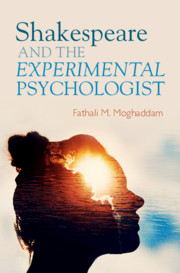Book contents
- Shakespeare and The Experimental Psychologist
- Shakespeare and The Experimental Psychologist
- Copyright page
- Dedication
- Contents
- Preface
- Acknowledgments
- Chapter 1 Introducing Shakespeare’s Psychological Thought Experiments
- Chapter 2 Experimental Research
- Part I Thought Experiments Involving Plays within Plays
- Part II Thought Experiments and the Power of Context
- Notes
- References
- Index
Chapter 1 - Introducing Shakespeare’s Psychological Thought Experiments
Published online by Cambridge University Press: 10 June 2021
- Shakespeare and The Experimental Psychologist
- Shakespeare and The Experimental Psychologist
- Copyright page
- Dedication
- Contents
- Preface
- Acknowledgments
- Chapter 1 Introducing Shakespeare’s Psychological Thought Experiments
- Chapter 2 Experimental Research
- Part I Thought Experiments Involving Plays within Plays
- Part II Thought Experiments and the Power of Context
- Notes
- References
- Index
Summary
Thought experiments, demonstrations or tests of particular ideas or hypotheses carried out in the imagination, play a central role in both science and in Shakespeare’s plays – as well as in other important works in English literature. Some of the most important scientists in history, for example Albert Einstein, engaged almost exclusively in thought experiments. Shakespeare’s psychological thought experiments are among his most important contributions to human culture. These thought experiments range from tightly controlled studies that could be carried out in modern laboratories to field experiments that have more “real world” validity. Shakespeare’s thought experiments are part of the intellectual background to twenty-first-century experimental psychology. These thought experiments are part of the scientific revolution taking place during Shakespeare’s era; their neglect reflects the unhealthy and unwise gap between the two cultures of science and art in the modern era. Through a focus on the common and key role of thought experiments in science and literature, we an help bridge the gap between science and art.
Keywords
- Type
- Chapter
- Information
- Shakespeare and the Experimental Psychologist , pp. 1 - 16Publisher: Cambridge University PressPrint publication year: 2021



